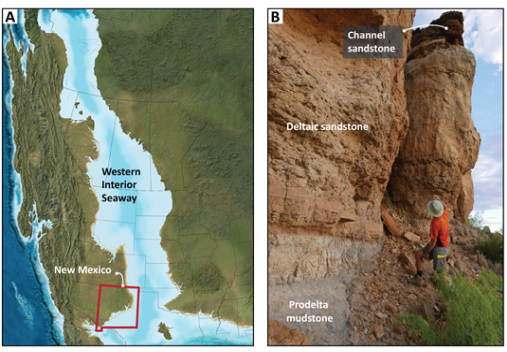Universitetet i Oslo er for tiden stengt, og disputasen vil derfor bli strømmet direkte via Zoom. Verten vil moderere det digitale mens disputaslederen moderer disputasen.
Ex auditorio-spørsmål: Disputasleder vil invitere til ex auditorio-spørsmål, og disse kan foretas enten skriftlig eller muntlig ved å klikke "Participants -> Raise hand".
Prøveforelesning
Factors and processes controlling depositional style in cratonic basins
Kreeringssammendrag
Det nordamerikanske kontinentet ble i det meste av kritt (145–66 mill år siden) delt i to av et stort innhav – Western Interior Seaway. I avhandlingen er det undersøkt et stort elvesystem som drenerte ned i innhavet. Sedimentære avsetninger i elvesystemet (en del av Dakota Group; ~ 100–98 myr) og tilhørende delta er usedvanlig sandrike. Mekanismer nødvendig for å avsette slike utbredte sandsteiner i deltaet blir påvist i avhandlingen. Det fremheves også at slike sandrike avsetninger utfordrer vår forståelse av balansen mellom erosjon og avsetninger generelt, men spesielt i grunne innhav.
Hovedfunn
Populærvitenskapelig artikkel om van Yperens avhandling:
The storage of sediment and time in ancient shallow-water deltas
Approximately 500 million people live on delta plains, which are increasingly exposed to flood hazards arising from climate extremes and relative sea-level rise. The saying ‘the past is the key to the future’ illustrates how the study of ancient deltas can help to assess potential impacts of relative sea-level rise on low-gradient delta plains. In addition, sandy deposits of ancient deltas tend to be good reservoirs for water, petroleum, or storage of CO2. However, not every delta is sandy. Therefore, it is necessary to improve our understanding of deltas in general, and deltas deposited in shallow water depths in particular because these are studied less.

This PhD focuses on a river-to-delta system draining into a shallow inland sea (i.e. the Western Interior Seaway) which divided the North American continent into two during the Cretaceous period. A ~400 km long transect exhumed from southeast Colorado to central-east New Mexico (USA) offers a full river-to-delta transect (Dakota Group, Mesa Rica Sandstone). Sedimentological fieldwork reveals that these river and delta deposits are very sand-prone, which is explained by depositional mechanisms resulting from the combined effects of high sandy sediment supply and the shallow water depth of the inland sea. This adds another mechanism to the classical relation between wave-dominance and laterally extensive sandstone deposits. It also highlights that the shallow water suppresses vertical stacking of sediment and promotes lateral and progradational stacking. Hence, the recording of elapsed time within such setting is in three dimensions with a strong lateral aspect, rather than by only vertical accumulation. Mudstone and / or siltstone deposits often contain more time than sandstone deposits and can record subordinate processes in the basin, such as tide- or wave energy.
The near-absence of these fine-grained facies in shallow-water settings might cause underestimation of the true influence of subordinate coastal processes, with important implications towards prediction of facies changes, and time and sediment distribution in other similar settings. Additionally, predictable patterns at mouth-bar scale are recognized which allows further subdivision. This is applicable to other deltas and can guide prediction of facies changes and sand distribution. Finally, this doctoral work suggests a revised theoretical model for the correlation of related river- and delta deposits.
Foto og annen informasjon:
Pressefoto: Anna Elisabeth van Yperen, portrett; 500px. Foto: Privat | Foto fra feltarbeid, New Mexico; størrelse 1000px. Foto: Privat
Annet bildemateriale: Illustrasjon (A) og foto (B) med beskrivelse og krediteringer som spesifisert i artikkelen over, størrelse 535px.
